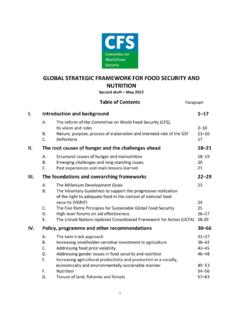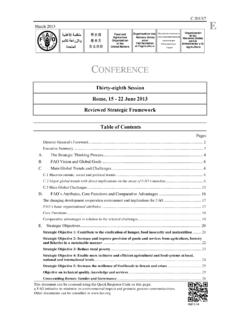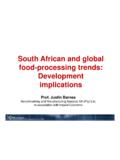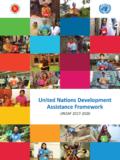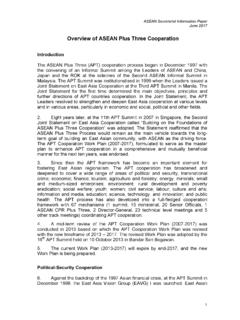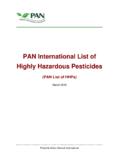Transcription of FROM MDGs TO SDGs: GENERAL INTRODUCTION
1 FROM MDGs TO SDGs: GENERAL INTRODUCTION1 SUMMARYThis report aims to describe global health in 2015, looking back 15 years at the trends and positive forces during the Millennium Development Goal (MDG) era and assessing the main challenges for the coming 15 2030 Sustainable Development Agenda is of unprecedented scope and ambition, applicable to all countries, and goes well beyond the MDGs. While poverty eradication, health, education, and food security and nutrition remain priorities, the Sustainable Development Goals (SDGs) comprise a broad range of economic, social and environmental objectives, and offer the prospect of more peaceful and inclusive societies. Progress towards the MDGs, on the whole, has been remarkable, including, for instance, poverty reduction, education improvements and increased access to safe drinking-water.
2 Progress on the three health goals and targets has also been considerable. Globally, the HIV, tuberculosis (TB) and malaria epidemics were turned around , child mortality and maternal mortality decreased greatly (53% and 44%, respectively, since 1990), despite falling short of the MDG targets. During the MDG era, many global progress records were set. The MDGs have gone a long way to changing the way we think and talk about the world, shaping the international discourse and debate on development, and have also contributed to major increases in development assistance. However, several limitations of the MDGs have also become apparent, including a limited focus, resulting in verticalization of health and disease programmes in countries, a lack of attention to strengthening health systems, the emphasis on a one-size-fits-all development planning approach, and a focus on aggregate targets rather than 17 goals and 169 targets, including one specific goal for health with 13 targets, of the new development agenda integrate the three dimensions of sustainable development around people, planet, prosperity, peace and partnership.
3 The health goal is broad: Ensure healthy lives and promote well-being for all at all ages . Health has a central place as a major contributor to and beneficiary of sustainable development policies. There are many linkages between the health goal and other goals and targets, reflecting the integrated approach that is underpinning the SDGs. Universal health coverage (UHC), one of the 13 health goal targets, provides an overall framework for the implementation of a broad and ambitious health agenda in all and review of progress will be a critical element of the SDGs. An indicator framework is still being developed and is scheduled to be adopted in 2016. 3 FROM MDGs TO SDGs: GENERAL INTRODUCTIONOn 25 September 2015, the United Nations (UN) GENERAL Assembly adopted the new development agenda Transforming our world: the 2030 agenda for sustainable development.
4 1 The new agenda is of unprecedented scope and ambition, and applicable to all countries. The post-2015 framework goes far beyond the MDGs, which nevertheless provided an important framework for combatting poverty and promoting development in low- and middle-income countries during the past 15 years. While poverty eradication, health as a basic human right, education, and food security and nutrition remain priorities, the SDGs comprise a broad range of economic, social and environmental objectives, as well as offering the promise of more peaceful and inclusive societies. The 17 goals and 169 targets, including one specific goal for health with 13 targets, have many linkages and cross-cutting elements, reflecting the integrated approach that underpins the report aims to describe global health in 2015, looking back 15 years at the trends and positive forces during the MDG era and assessing the main challenges for the coming 15 years.
5 The following chapter describes the context, including population and epidemiological changes, and the economic, social and environmental determinants of health. The subsequent six chapters present the trends and challenges for the main health areas that are prominent in the health goal of the SDGs: UHC; reproductive, maternal, newborn, child and adolescent health; infectious diseases; noncommunicable diseases (NCDs); mental health and substance abuse; and injuries and violence. Some chapters cover multiple health targets and, where relevant, refer to SDG targets that are in other goals. The final chapter reflects on the implications of the SDG for chapter summarizes the achievements and progress towards the health-related MDGs since 2000, or trends in areas that were not prioritized in the MDGs. Key factors that have contributed to the success of the past 15 years are identified, ranging from country actions to global partnerships, funding increases and scale-up of new interventions.
6 The major challenges for health in 2015 and the next 15 years are also summarized. The last part of each chapter puts together the strategic priorities as defined in the SDG targets, and links those to World Health Organization (WHO) resolutions, global action plans and other critical strategic documents. For many areas, the World Health Assembly has already laid out what countries and the international community should prioritize to make significant progress towards the new SDG targets. In many other areas, the SDGs offer a new, broader and integrated perspective that needs further concretization and impetus in regard to UHC and intersectoral introductory chapter starts with a brief review of the GENERAL health-related MDG achievements, strengths and limitations. The second part describes the health-related SDG targets, including how health is reflected in other goals and targets, and discusses how the monitoring of progress towards the health-related SDG can be September 2000, the UN GENERAL Assembly adopted the Millennium Declaration, establishing a global partnership of countries and development partners committed to eight voluntary development goals, to be achieved by 2015.
7 Representing ambitious moral and practical commitments, the MDGs2 called for action to: (1) eradicate extreme poverty and hunger; (2) achieve universal primary education; (3) promote gender equality and empower women; (4) reduce child mortality; (5) improve maternal health; (6) combat HIV/AIDS, malaria and other diseases; (7) ensure environmental sustainability; and (8) develop a global partnership for development. Three of the eight MDGs are focused on health, while health is also a component of several other MDGs (nutrition, water and sanitation).3 There has been unprecedented mobilization of resources around MDG-related activities across a wide spectrum of global and national initiatives and the development community has convened on a regular basis to assess progress.
8 Major global events related to the MDGs include: the 2001 and 2011 UN special sessions on HIV/AIDS, convened to intensify international activity to fight the epidemic;4 the 2005 World Summit,5 which reaffirmed the commitments to the Millennium Declaration; the 2008 high-level event at the UN in New York,6 at which there was a call to accelerate progress towards the MDGs; the 2010 Millennium Development Goals Summit, which concluded with the adoption of a global Action Plan and the announcement of multiple initiatives against poverty, hunger and disease, as well as initiatives designed to accelerate progress on women s and children s health, and at which specific MDG-related commitments were made by countries and others;7 and, most recently, the 2013 UN special event to follow up on MDG-related Many regional and country events have also been held to review progress and make new commitments.
9 The MDGs have gone a long way to changing the way we think and talk about the world, shaping the international discourse and debate on development, and stimulating popular awareness of moral imperatives such as achieving gender equality and ending poverty and starvation. The MDGs have also contributed to major increases in development assistance,8,9,10 as evidenced by the 66% jump in official development assistance (ODA, in real terms) between 2000 and 2014 when it reached an unprecedented US$ 135 More aid has flowed into education and public health, while also being directed towards poorer countries to supplement the increases in domestically 4 HEALTH IN 2015: FROM MDGs TO SDGsTable global and WHO regional status of the health-related MDGsTargetGlobalAFRAMRSEAREUREMRWPRT arget , between 1990 and 2015, the proportion of people who suffer from hungerPercent reduction in proportion of underweight children under-five years of age, 1990 20155044356349853982 Target by two thirds, between 1990 and 2015, the under-five mortality ratePercent reduction in under-five mortality rate, 1990 20156753546564654874 Measles immunization coverage among one-year-oldsa (%), 20149085739284947797 Target by three quarters, between 1990 and 2015, the maternal mortality ratioPercent reduction in maternal mortality ratio, 1990 20157544444969635464 Births attended by skilled health personnelb (%), 20139073549659996795 Target , by 2015, universal access to reproductive healthAntenatal care coverage (%).
10 At least one visit, 201310088819984997995 Unmet need for family planning (%), 2015024551927284210 Target halted by 2015 and begun to reverse the spread of HIV/AIDSP ercent reduction in HIV incidence, 2000 2014>045592850-16< -5027 Target halted by 2015 and begun to reverse the incidence of malaria and other major diseasesPercent reduction in incidence of malaria, 2000 2015>0374278491007065 Percent reduction in incidence of tuberculosis, 1990 2014>01714917141248 Target , by 2015, the proportion of people without sustainable access to safe drinking-waterPercent reduction in proportion of population without access to improved drinking-water sources, 1990 20155062386274673984 Percent reduction in proportion of population without access to improved sanitation, 1990 2015503174732285454 AFR, African Region; AMR, Region of the Americas; SEAR, South-East Asia Region; EUR, European Region; EMR, Eastern Mediterranean Region; WPR, Western Pacific Target for measles immunization coverage was set by the World Health Target for births attended by skilled health personnel was set by the International Conference on Population and Development.










